Framework Manager使用手册
- 格式:doc
- 大小:1.33 MB
- 文档页数:15
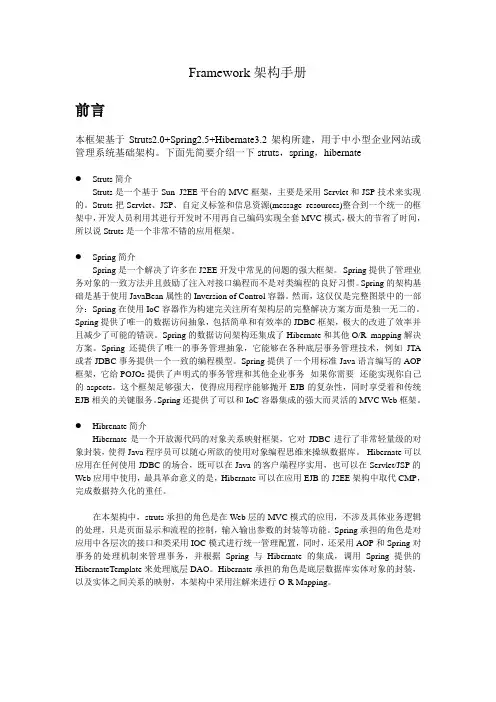
Framework架构手册前言本框架基于Struts2.0+Spring2.5+Hibernate3.2架构所建,用于中小型企业网站或管理系统基础架构。
下面先简要介绍一下struts,spring,hibernate●Struts简介Struts是一个基于Sun J2EE平台的MVC框架,主要是采用Servlet和JSP技术来实现的。
Struts把Servlet、JSP、自定义标签和信息资源(message resources)整合到一个统一的框架中,开发人员利用其进行开发时不用再自己编码实现全套MVC模式,极大的节省了时间,所以说Struts是一个非常不错的应用框架。
●Spring简介Spring是一个解决了许多在J2EE开发中常见的问题的强大框架。
Spring提供了管理业务对象的一致方法并且鼓励了注入对接口编程而不是对类编程的良好习惯。
Spring的架构基础是基于使用JavaBean属性的Inversion of Control容器。
然而,这仅仅是完整图景中的一部分:Spring在使用IoC容器作为构建完关注所有架构层的完整解决方案方面是独一无二的。
Spring提供了唯一的数据访问抽象,包括简单和有效率的JDBC框架,极大的改进了效率并且减少了可能的错误。
Spring的数据访问架构还集成了Hibernate和其他O/R mapping解决方案。
Spring还提供了唯一的事务管理抽象,它能够在各种底层事务管理技术,例如JTA 或者JDBC事务提供一个一致的编程模型。
Spring提供了一个用标准Java语言编写的AOP 框架,它给POJOs提供了声明式的事务管理和其他企业事务--如果你需要--还能实现你自己的aspects。
这个框架足够强大,使得应用程序能够抛开EJB的复杂性,同时享受着和传统EJB相关的关键服务。
Spring还提供了可以和IoC容器集成的强大而灵活的MVC Web框架。
●Hibrenate简介Hibernate是一个开放源代码的对象关系映射框架,它对JDBC进行了非常轻量级的对象封装,使得Java程序员可以随心所欲的使用对象编程思维来操纵数据库。
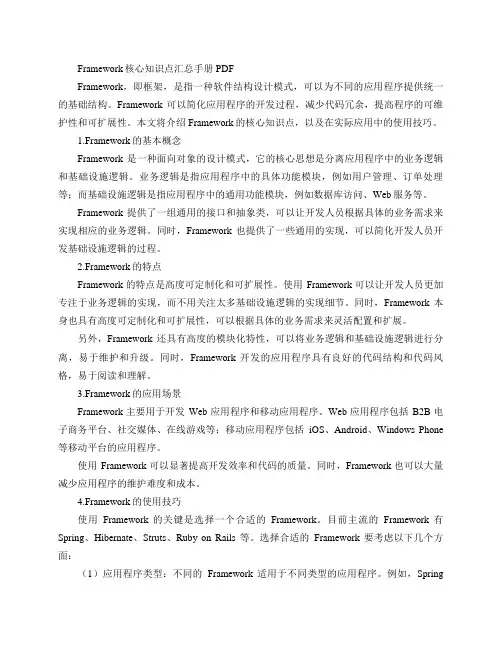
Framework核心知识点汇总手册PDFFramework,即框架,是指一种软件结构设计模式,可以为不同的应用程序提供统一的基础结构。
Framework可以简化应用程序的开发过程,减少代码冗余,提高程序的可维护性和可扩展性。
本文将介绍Framework的核心知识点,以及在实际应用中的使用技巧。
1.Framework的基本概念Framework是一种面向对象的设计模式,它的核心思想是分离应用程序中的业务逻辑和基础设施逻辑。
业务逻辑是指应用程序中的具体功能模块,例如用户管理、订单处理等;而基础设施逻辑是指应用程序中的通用功能模块,例如数据库访问、Web服务等。
Framework提供了一组通用的接口和抽象类,可以让开发人员根据具体的业务需求来实现相应的业务逻辑。
同时,Framework也提供了一些通用的实现,可以简化开发人员开发基础设施逻辑的过程。
2.Framework的特点Framework的特点是高度可定制化和可扩展性。
使用Framework可以让开发人员更加专注于业务逻辑的实现,而不用关注太多基础设施逻辑的实现细节。
同时,Framework本身也具有高度可定制化和可扩展性,可以根据具体的业务需求来灵活配置和扩展。
另外,Framework还具有高度的模块化特性,可以将业务逻辑和基础设施逻辑进行分离,易于维护和升级。
同时,Framework开发的应用程序具有良好的代码结构和代码风格,易于阅读和理解。
3.Framework的应用场景Framework主要用于开发Web应用程序和移动应用程序。
Web应用程序包括B2B电子商务平台、社交媒体、在线游戏等;移动应用程序包括iOS、Android、Windows Phone 等移动平台的应用程序。
使用Framework可以显著提高开发效率和代码的质量。
同时,Framework也可以大量减少应用程序的维护难度和成本。
4.Framework的使用技巧使用Framework的关键是选择一个合适的Framework。

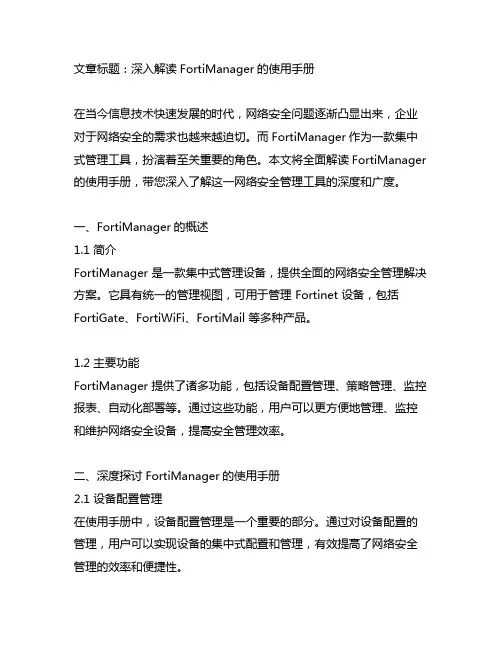
文章标题:深入解读FortiManager的使用手册在当今信息技术快速发展的时代,网络安全问题逐渐凸显出来,企业对于网络安全的需求也越来越迫切。
而FortiManager作为一款集中式管理工具,扮演着至关重要的角色。
本文将全面解读FortiManager 的使用手册,带您深入了解这一网络安全管理工具的深度和广度。
一、FortiManager的概述1.1 简介FortiManager 是一款集中式管理设备,提供全面的网络安全管理解决方案。
它具有统一的管理视图,可用于管理 Fortinet 设备,包括FortiGate、FortiWiFi、FortiMail 等多种产品。
1.2 主要功能FortiManager 提供了诸多功能,包括设备配置管理、策略管理、监控报表、自动化部署等。
通过这些功能,用户可以更方便地管理、监控和维护网络安全设备,提高安全管理效率。
二、深度探讨FortiManager的使用手册2.1 设备配置管理在使用手册中,设备配置管理是一个重要的部分。
通过对设备配置的管理,用户可以实现设备的集中式配置和管理,有效提高了网络安全管理的效率和便捷性。
2.2 策略管理FortiManager 使用手册中详细介绍了策略管理的内容,包括安全策略、NAT 策略、路由策略等。
这些策略的灵活管理,可以满足不同网络环境下的安全管理需求。
2.3 监控报表在使用手册中,监控报表模块包括了日志报表、监控报表等。
这些报表提供了全面的网络安全监控数据,帮助用户及时发现并解决网络安全问题。
2.4 自动化部署使用手册还介绍了 FortiManager 的自动化部署功能,通过自动化部署,用户可以更快速、更方便地部署网络安全设备。
三、总结与回顾通过对FortiManager使用手册的深度探讨,我们对这一网络安全管理工具有了更全面、更深入的理解。
从设备配置管理到策略管理,从监控报表到自动化部署,FortiManager 提供了全面的解决方案,帮助用户更好地管理网络安全。
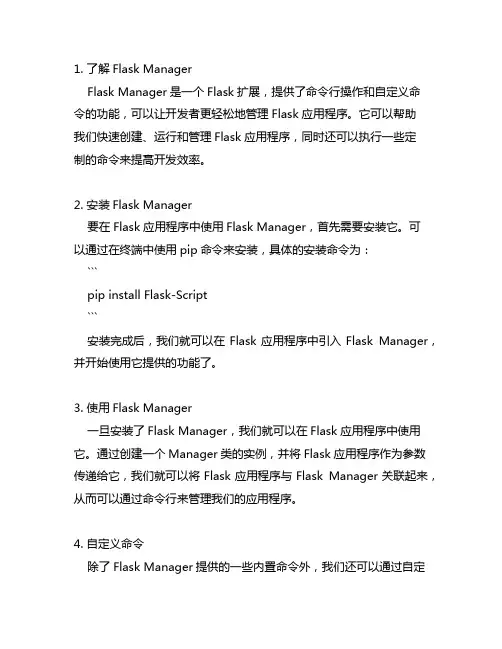
1. 了解Flask ManagerFlask Manager是一个Flask扩展,提供了命令行操作和自定义命令的功能,可以让开发者更轻松地管理Flask应用程序。
它可以帮助我们快速创建、运行和管理Flask应用程序,同时还可以执行一些定制的命令来提高开发效率。
2. 安装Flask Manager要在Flask应用程序中使用Flask Manager,首先需要安装它。
可以通过在终端中使用pip命令来安装,具体的安装命令为:```pip install Flask-Script```安装完成后,我们就可以在Flask应用程序中引入Flask Manager,并开始使用它提供的功能了。
3. 使用Flask Manager一旦安装了Flask Manager,我们就可以在Flask应用程序中使用它。
通过创建一个Manager类的实例,并将Flask应用程序作为参数传递给它,我们就可以将Flask应用程序与Flask Manager关联起来,从而可以通过命令行来管理我们的应用程序。
4. 自定义命令除了Flask Manager提供的一些内置命令外,我们还可以通过自定义命令来扩展其功能。
通过在Manager类的实例上调用命令装饰器,并定义一个函数来实现命令的具体逻辑,我们就可以添加自己的命令。
这样一来,我们可以根据自己的需求,添加一些特定于项目的管理命令,以提高开发效率。
5. 总结和回顾在本文中,我们首先了解了Flask Manager的作用和优势,然后介绍了如何安装和使用它,并且提到了自定义命令的用法。
通过对Flask Manager的全面评估和深度探讨,相信读者已经对其有了更深入的理解和掌握。
我个人认为Flask Manager是一个非常实用的工具,它可以让我们更轻松地管理和维护我们的Flask应用程序,提高开发效率。
6. 结语通过本文对Flask Manager的介绍和讨论,希望读者能更加深入地了解和掌握这个工具,从而能够更好地应用到实际的项目开发中。
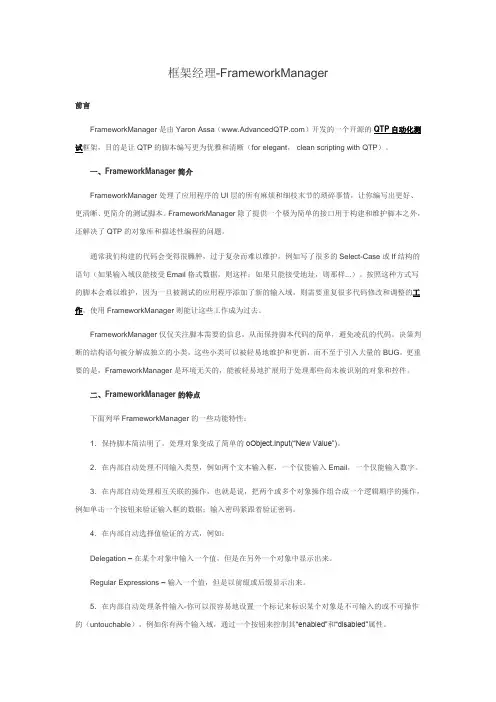
框架经理-FrameworkManager前言FrameworkManager是由Yaron Assa()开发的一个开源的QTP自动化测试框架,目的是让QTP的脚本编写更为优雅和清晰(for elegant, clean scripting with QTP)。
一、FrameworkManager简介FrameworkManager处理了应用程序的UI层的所有麻烦和细枝末节的琐碎事情,让你编写出更好、更清晰、更简介的测试脚本。
FrameworkManager除了提供一个极为简单的接口用于构建和维护脚本之外,还解决了QTP的对象库和描述性编程的问题。
通常我们构建的代码会变得很臃肿,过于复杂而难以维护,例如写了很多的Select-Case或If结构的语句(如果输入域仅能接受Email格式数据,则这样;如果只能接受地址,则那样...)。
按照这种方式写的脚本会难以维护,因为一旦被测试的应用程序添加了新的输入域,则需要重复很多代码修改和调整的工作,使用FrameworkManager则能让这些工作成为过去。
FrameworkManager仅仅关注脚本需要的信息,从而保持脚本代码的简单,避免凌乱的代码。
决策判断的结构语句被分解成独立的小类,这些小类可以被轻易地维护和更新,而不至于引入大量的BUG。
更重要的是,FrameworkManager是环境无关的,能被轻易地扩展用于处理那些尚未被识别的对象和控件。
二、FrameworkManager的特点下面列举FrameworkManager的一些功能特性:1.保持脚本简洁明了。
处理对象变成了简单的oObject.Input(“New Value”)。
2.在内部自动处理不同输入类型,例如两个文本输入框,一个仅能输入Email,一个仅能输入数字。
3.在内部自动处理相互关联的操作,也就是说,把两个或多个对象操作组合成一个逻辑顺序的操作,例如单击一个按钮来验证输入框的数据;输入密码紧跟着验证密码。
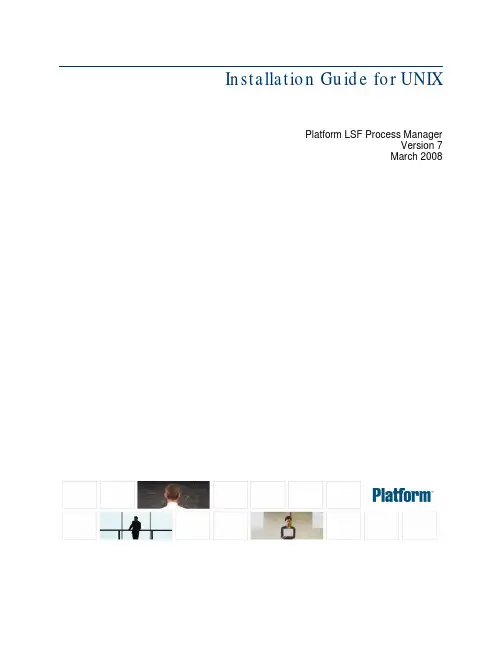
Installation Guide for UNIXPlatform LSF Process ManagerVersion 7March 2008Copyright© 1994-2008 Platform Computing CorporationAll rights reserved.Although the information in this document has been carefully reviewed, Platform Computing Corporation (“Platform”) does notwarrant it to be free of errors or omissions. Platform reserves the right to make corrections, updates, revisions or changes to theinformation in this document.UNLESS OTHERWISE EXPRESSLY STATED BY PLATFORM, THE PROGRAM DESCRIBED IN THIS DOCUMENT ISPROVIDED “AS IS” AND WITHOUT WARRANTY OF ANY KIND, EITHER EXPRESSED OR IMPLIED, INCLUDING, BUTNOT LIMITED TO, THE IMPLIED WARRANTIES OF MERCHANTABILITY AND FITNESS FOR A PARTICULAR PURPOSE.IN NO EVENT WILL PLATFORM COMPUTING BE LIABLE TO ANYONE FOR SPECIAL, COLLATERAL, INCIDENTAL, ORCONSEQUENTIAL DAMAGES, INCLUDING WITHOUT LIMITATION ANY LOST PROFITS, DATA, OR SAVINGS, ARISINGOUT OF THE USE OF OR INABILITY TO USE THIS PROGRAM.We’d like to hear from you You can help us make this document better by telling us what you think of the content, organization, and usefulness of the information. If you find an error, or just want to make a suggestion for improving this document, please address your comments to****************.YourcommentsshouldpertainonlytoPlatformdocumentation.Forproductsupport,***************************.Documentredistribution andtranslationThis document is protected by copyright and you may not redistribute or translate it into another language, in part or in whole.Internal redistribution You may only redistribute this document internally within your organization (for example, on an intranet) provided that you continue to check the Platform Web site for updates and update your version of the documentation. You may not make it available to your organization over the Internet.Trademarks® LSF is a registered trademark of Platform Computing Corporation in the United States and in other jurisdictions.™ ACCELERATING INTELLIGENCE, PLATFORM COMPUTING, PLATFORM SYMPHONY, PLATFORM JOBSCHEDULER,PLATFORM ENTERPRISE GRID ORCHESTRATOR, PLATFORM EGO, and the PLATFORM and PLATFORM LSF logos aretrademarks of Platform Computing Corporation in the United States and in other jurisdictions.® UNIX is a registered trademark of The Open Group in the United States and in other jurisdictions.Linux® is the registered trademark of Linus Torvalds in the U.S. and other countries.Microsoft is either a registered trademark or a trademark of Microsoft Corporation in the United States and/or other countries.® Windows is a registered trademark of Microsoft Corporation in the United States and other countries.Intel®, Itanium, and Pentium are trademarks or registered trademarks of Intel Corporation or its subsidiaries in the United States andother countries.Other products or services mentioned in this document are identified by the trademarks or service marks of their respective owners.Third-party licenseagreements/Company/third.part.license.htmThird-partycopyright notices/Company/Third.Party.Copyright.htmContents1Introduction (5)Supported versions and requirements (6)Installation directories (7)Pre-installation requirements (9)2Before you install (10)Prepare distribution files (11)Edit install.config (12)Using 64-bit hardware in 32-bit Kernel mode on an AIX5 platform (13)Install library patch upgrade for Solaris 2.7 64-bit machine (14)3Run the install script (15)4Start the Process Manager Server (17)Set the client environment (18)Installation Guide for UNIX 34 Installation Guide for UNIXC H A P T E R1IntroductionThis document describes how to install the software required to run the Platform LSF Process Manager™ software (“Process Manager”) on UNIX hosts. The Process Manager software includes the Process Manager™ Server and Client. Both of these components is required to run jobs using the Process Manager.The Process Manager Server controls the submission of jobs to LSF, managing any dependencies between the jobs. LSF dispatches all jobs submitted to it by the Process Manager Server, and returns the status of each jobs to the Process Manager Server. LSF also manages any resource requirements and performs load balancing within the compute cluster. The Process Manager Client allows you to monitor your workload as it runs.You can install all of the components on a single host, or you can install the Process Manager Server and LSF on separate hosts. This document describes how to install all components on a single host.For an overview of the Process Manager components, see the introductory chapter in Administering Process Manager. AssumptionsThe following instructions assume that:•You have installed LSF.•The Process Manager Server and Client will be installed on a single UNIX host. This host will act as the central point of control for a cluster of LSF hosts that actually run the jobs.•You are creating an LSF cluster composed of only UNIX hosts. There will be no Windows hosts in your cluster.Installation Guide for UNIX 5IntroductionSupported versions and requirementsThe Process Manager software must be installed on an LSF server host, but it is recommended that it not be an LSF master host.J2RE (Java Runtime Environment) 1.4 is installed with the Process Manager.The Process Manager Server requires:•Approximately 135 MB free disk space for installation, and an additional 2 KB per job to handle jobs running simultaneously•256 MB RAM for processing purposes6 Installation Guide for UNIXIntroduction Installation directoriesThe Process Manager installation produces the following directory structure:•Machine-independent files are independent of the host type, and are shared by all host types (man pages, configuration files, include files, examples, etc.)•JS_TOP is the directory in which the Process Manager Server and Client files are installed. For example: /usr/local/ppmInstallation Guide for UNIX 7Introduction8 Installation Guide for UNIXPre-installation requirements Pre-installation requirements•License file for Platform LSF Process Manager.• A shared file system for the hosts. The shared file system needs to be writable by root during the installation.•The installation must be performed as root. This includes the distribution installation as well as the host setup steps.The root account must be able to write into the file system mounted at LSF_TOP.Installation Guide for UNIX 9Before you install2Before you installThe following instructions assume you are installing both LSF and Process Manager together on the same UNIX host.Caution:Do not install Process Manager and LSF to the same directory.Copy the license file contents into a file Process Manager can access the license information. For example, create a file called license.dat.10 Installation Guide for UNIXBefore you install Prepare distribution files1.Log in as root to one of the hosts that will be running LSF jobs.2.Get the distribution tar files for all host types you need. For example, for AIX, you need the following files:•ppm7_server_aix5-64.tar.Z•ppm7_client_flowmanager_aix5-64.tar.Z•ppm7_client_editors_aix5-64.tar.ZDo not extract the distribution tar files.Get the installation script tar file and extract it:zcat ppm7_pinstall.tar.Z|tar xvf -This creates a directory called ppm7_pinstall, containing the following:a)install.config—the configuration file where you define your installation prior to installingb)jsinstall—the install script for installing both Process Manager Server and ClientBefore you installEdit install.config1.Change to the ppm7_pinstall directory:cd ppm7_pinstall2.As an administrator, edit ppm7_pinstall/install.config to define your configuration.Remove the comment symbol (#) and set values for the following parameters:a)JS_TOPSpecify the full path to the Process Manager directory. For example:JS_TOP=/usr/share/jsb)JS_HOSTSpecify the fully-qualified host name of the Process Manager Server host. For example:JS_HOST=c)JS_PORT=1966Use the default port number, 1966.Ensure that you change this value if another process is already using the port. For example:JS_PORT=1234d)JS_ADMINSSpecify the user name of the primary LSF administrator. For example:JS_ADMINS=lsfadmine)JS_LICENSESpecify the full path and name of the license file. For example:JS_LICENSE=/usr/share/license.datf)LSF_ENVDIRSpecifies the directory where the LSF configuration files are stored. For example: LSF_ENVDIR=/usr/share/ lsf/conf.3.Save install.config.Before you install Using 64-bit hardware in 32-bit Kernel mode on an AIX5 platformIf a host has 64-bit hardware but runs in 32-bit kernel mode, you must install and enable the bos.64bit fileset.Before you installInstall library patch upgrade for Solaris 2.7 64-bit machineIf you are running Process Manager on a Solaris 2.7 64-bit machine, you need to ensure that you have the latest shared library patch for C++ from Sun Microsystems.1.Navigate to Sun Microsystem’s patch access.2.Search for patch 106327-23 and download it. (This patch is dependent on 106950-13 or greater.)3.Unzip files to a temporary directory and apply the patch.C H A P T E R3Run the install script1.As root, run the install script as follows:./jsinstall -f install.configThis installs Process Manager. A directory is created and an Install.log file is created. All the events of the installation are logged here.2.Review the license agreement.3.Accept the terms and conditions of the agreement by specifying y.4.When prompted, select the Process Manager Server and Clients for the current operating system, and press Enter.A message tells you when installation is successful.Run the install scriptC H A P T E R4 Start the Process Manager Server1.After the installation is complete, set the Process Manager environment:•On csh or tcsh:source JS_TOP/conf/cshrc.js•On sh, ksh or bash:. JS_TOP/conf/profile.jswhere JS_TOP is the top-level Process Manager installation directory, the value specified in theinstall.config file.2.Run jadmin start to start the Process Manager Server:jadmin start3.To start the daemon on the Server host at boot time, run bootsetup on the Server host.Start the Process Manager ServerSet the client environment1.Set the Process Manager environment on each client:•On csh or tcsh:source JS_TOP/conf/cshrc.js•On sh, ksh or bash:. JS_TOP/conf/profile.jswhere JS_TOP is the top-level Process Manager installation directory, the value specified in theinstall.config file.2.After the Process Manager Server has started, run the client applications to verify the success of the installation:a)Run floweditorb)Run flowmanagerc)Run caleditorBoth the Calendar Editor and the Flow Manager require a connection to the Server to be able to start. If you are unable to start either application, there is an error in the configuration, or the Server is not started.。
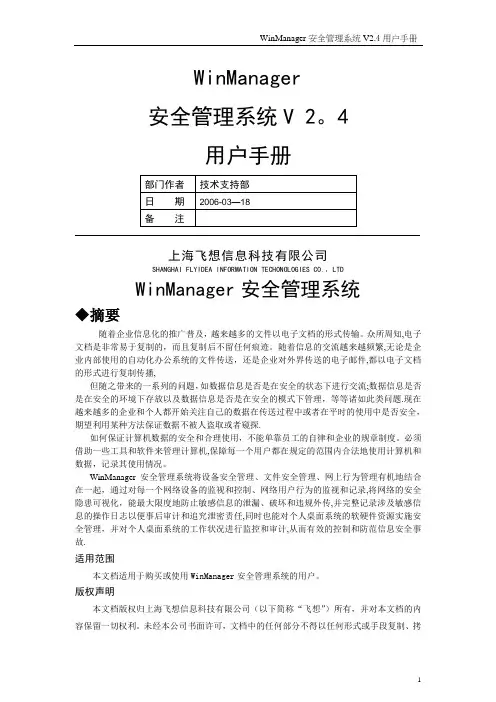
WinManager安全管理系统V 2。
4用户手册上海飞想信息科技有限公司SHANGHAI FLYIDEA INFORMATION TECHONOLOGIES CO.,LTDWinManager安全管理系统◆摘要随着企业信息化的推广普及,越来越多的文件以电子文档的形式传输。
众所周知,电子文档是非常易于复制的,而且复制后不留任何痕迹。
随着信息的交流越来越频繁,无论是企业内部使用的自动化办公系统的文件传送,还是企业对外界传送的电子邮件,都以电子文档的形式进行复制传播,但随之带来的一系列的问题,如数据信息是否是在安全的状态下进行交流;数据信息是否是在安全的环境下存放以及数据信息是否是在安全的模式下管理,等等诸如此类问题.现在越来越多的企业和个人都开始关注自己的数据在传送过程中或者在平时的使用中是否安全,期望利用某种方法保证数据不被人盗取或者窥探.如何保证计算机数据的安全和合理使用,不能单靠员工的自律和企业的规章制度。
必须借助一些工具和软件来管理计算机,保障每一个用户都在规定的范围内合法地使用计算机和数据,记录其使用情况。
WinManager安全管理系统将设备安全管理、文件安全管理、网上行为管理有机地结合在一起,通过对每一个网络设备的监视和控制、网络用户行为的监视和记录,将网络的安全隐患可视化,能最大限度地防止敏感信息的泄漏、破坏和违规外传,并完整记录涉及敏感信息的操作日志以便事后审计和追究泄密责任,同时也能对个人桌面系统的软硬件资源实施安全管理,并对个人桌面系统的工作状况进行监控和审计,从而有效的控制和防范信息安全事故.适用范围本文档适用于购买或使用WinManager安全管理系统的用户。
版权声明本文档版权归上海飞想信息科技有限公司(以下简称“飞想”)所有,并对本文档的内容保留一切权利。
未经本公司书面许可,文档中的任何部分不得以任何形式或手段复制、拷贝、传播给其它第三方.免责声明本文档为飞想提供给用户的技术文档,只作为产品的说明,不作为合同要约。

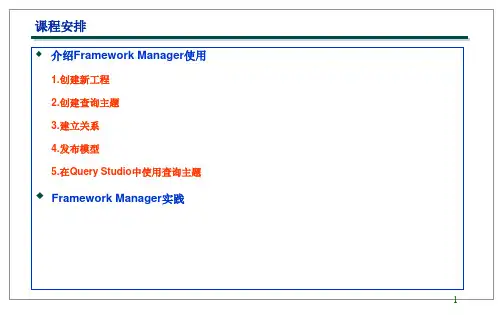
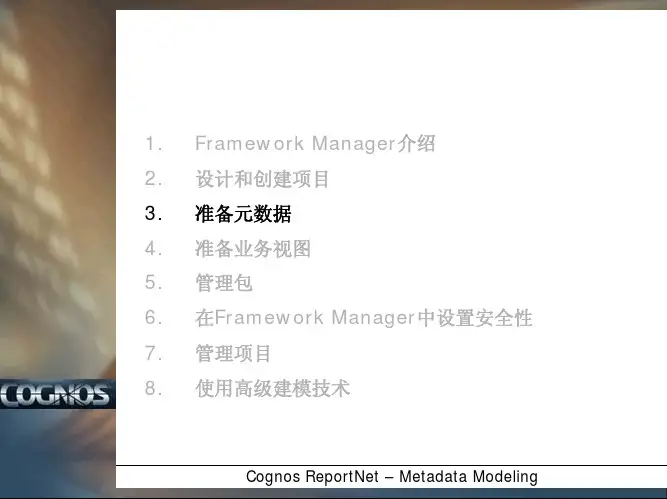
manager层用法在软件开发中,为了更好地组织和管理代码,提高代码的可维护性和可扩展性,常常会采用分层架构的设计模式。
其中,manager层是一种常见的设计模式,用于处理业务逻辑和数据操作。
首先,manager层是位于业务逻辑层和数据访问层之间的一层,负责协调和处理业务逻辑。
它的主要作用是将业务逻辑从数据访问层中解耦出来,使得业务逻辑更加清晰和可复用。
通过将业务逻辑封装在manager层中,可以使得不同的业务逻辑之间相互独立,提高代码的可维护性。
其次,manager层还负责与数据访问层进行交互,完成对数据库的操作。
它可以调用数据访问层提供的接口,进行数据的增删改查等操作。
通过将数据访问层与业务逻辑层分离,可以使得数据访问层更加专注于数据的存储和查询,提高代码的可扩展性。
在实际应用中,manager层的使用可以带来很多好处。
首先,它可以提高代码的可读性和可维护性。
通过将业务逻辑封装在manager层中,可以使得代码更加清晰和易于理解。
同时,由于业务逻辑与数据访问层解耦,可以更加方便地修改和扩展业务逻辑,而不会对数据访问层产生影响。
其次,manager层的使用可以提高代码的复用性。
通过将相同的业务逻辑封装在不同的manager中,可以在不同的模块中复用这些业务逻辑,避免了重复编写代码的问题。
这样可以提高开发效率,减少代码的冗余。
此外,manager层还可以提供一定的安全性和可靠性。
通过在manager层中进行数据校验和异常处理,可以保证数据的有效性和一致性。
同时,由于manager层与数据访问层解耦,可以更加方便地进行单元测试和集成测试,提高代码的质量和稳定性。
然而,manager层的使用也需要注意一些问题。
首先,manager层的设计应该符合单一职责原则,即每个manager只负责一个具体的业务逻辑。
这样可以使得代码更加清晰和易于维护。
其次,manager层的接口设计应该合理,避免暴露过多的细节和实现细节。
综合平台及物料平衡安装配置手册目录综合平台及物料平衡 (1)安装配置手册 (1)第一章前言 (4)第二章系统配置要求 (5)2.1 系统软件要求 (5)2.2 系统硬件要求 (6)2.3 安装之前的检查 (7)第三章安装环境 (9)3.1 IIS 安装 (9)3.2 dotnetfxchs安装 (11)3.3 数据库环境 (11)3.4 综合展示环境 (14)3.5 物料平衡运行环境 (21)第四章综合平台安装与配置............................................................. 错误!未定义书签。
4.1 综合平台安装..................................................................... 错误!未定义书签。
4.2 修改所有已安装软件的Web.config文件................... 错误!未定义书签。
4.3 配置综合平台..................................................................... 错误!未定义书签。
4.3 配置综合展示..................................................................... 错误!未定义书签。
4.4 配置自定义工作台............................................................. 错误!未定义书签。
4.5 配置XMES ......................................................................... 错误!未定义书签。
第五章物料平衡的部署 (26)第六章客户端浏览器配置 (29)7.1 系统安全站点设置 (29)7.2 系统安全设置设定 (30)第七章程序的卸载 (32)8.1. 卸载的准备 (32)8.2 .卸载程序 (32)第一章前言本手册主要内容为:服务器硬件配置要求、安装之前的检查,综合平台、工厂建模、自定义工作台、综合展示等组件的安装和卸载,以及物料平衡软件的部署。
manager层用法 (1)在软件开发中,"manager"一词经常被用来表示一种特定的编程模式或者设计模式。
作为一种重要的设计模式,"manager"层被广泛应用于多种不同类型的项目中。
本文将介绍"manager"层在软件开发中的使用方法以及相关的一些最佳实践。
一、"Manager"层的定义和作用在软件开发中,"manager"层一般是指一种实现特定业务逻辑的对象或类。
它负责协调和管理其他对象或类的行为,以实现更高层次的功能。
"Manager"层通常通过封装复杂的业务逻辑和算法,提供简洁、易于使用的接口给上层模块。
二、"Manager"层的设计原则在设计"manager"层时,我们应该遵循一些重要的原则,以确保其良好的可维护性和可扩展性。
1.单一职责原则每个"manager"类应该只负责一种特定的功能或者业务逻辑。
这样可以使得代码更加清晰、易于理解,并且便于维护和扩展。
2.依赖倒置原则"manager"类不应该直接依赖于具体的实现类,而应该依赖于抽象接口。
这样可以使得代码更加灵活,方便替换实现类。
3.开闭原则"manager"类应该对扩展开放,对修改关闭。
也就是说,我们应该通过添加新的"manager"类来扩展功能,而不是对现有的"manager"类进行修改。
三、"Manager"层的使用场景"Manager"层可以应用于各种不同类型的软件项目,包括但不限于以下几个方面。
1.数据访问和持久化"Manager"层可以用于封装对数据库的访问和操作。
它可以处理数据库连接、事务管理和数据映射等复杂的底层细节,提供简洁、易于使用的接口给上层模块。
商帅系列软件用户手册1第一章产品安装第一节安装步骤运行安装程序;第一步:安装主程序;第二步:安装Firebird数据库驱动(服务器安装数据库服务器端,否则安装数据库客户端);第二节系统要求操作系统Windows98SE/MeWindows2000WindowsXPWindows2003数据库Firebird 1.5硬件您的PC必须有100 MHz的系统,建议用更高级别的系统。
必须有至少64MB RAM内存。
一般情况下,内存越多越好。
硬盘访问时间应该少于 19 毫秒。
图形卡有 4 MB 或更多显存(用于视频)。
建议屏幕分辨率为 1024x768 或更高,这样最适合工作。
第三节正式使用你可以通过以下途径获取正式版:直接向软件供应商购买;向软件代理商购买,请咨询软件供应商看当地是否有代理商;购买正式版后,将会提供您软件锁;将软件锁安装在USB接口上,即可以正式使用了如何发送短信:向软件供应商提供手机号码作为帐号并且购买充值卡;软件供应商将开通短信帐号和提供帐号密码以及充值卡;如需充值,请向软件供应商购买充值卡,然后通过短信帐号充值模块充值;第二章产品简介《商帅汽车业务管理系统》是立方至胜软件公司以多年行业经验综合众多典型客户的需求为基础最新推出的一款管理软件。
它以管理公司的进销存业务为基础,以管理汽车相关行业(汽修、汽配、汽车装饰)的业务为主线,全面管理公司的物流和钱流,并且融入了会员积分管理、客户关系管理、短信平台、消费卡管理、财务管理等,从而实现对公司业务的全方位管理。
《商帅汽车业务管理系统》是由“进销业务”、“维修业务”、“装饰业务”、“增强业务”四大部分组成。
其中“进销业务”是软件的核心部分,它包含“采购管理”、“销售管理”、“存库管理”、“帐务管理”、“经理查询”、“代收代付”、“其他管理”等七个主要模块。
“维修业务”和“装饰业务”包含相关业务管理模块和“消费卡管理”。
“增强业务”包含“客户管理”、“会员管理”、“车辆管理”、“提醒服务”、“汽贸管理”等。